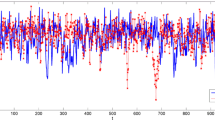Abstract
The water exchange matrix is an efficient tool to study the water exchange among the sub-areas in large-scale bays. The application of the random walk method to calculate the water exchange matrix is studied. Compared with the advection-diffusion model, the random walk model is more flexible to calculate the water exchange matrix. The forecast matrix suggested by Thompson et al. is used to evaluate the water exchange characteristics among the sub-areas fast. According to the theoretic analysis, it is found that the precision of the predicted results is mainly affected by three factors, namely, the particle number, the generated time of the forecast matrix, and the number of the sub-areas. The impact of the above factors is analyzed based on the results of a series of numerical tests. The results show that the precision of the forecast matrix increases with the increase of the generated time of the forecast matrix and the number of the particles. If there are enough particles in each sub-area, the precision of the forecast matrix will increase with the number of the sub-areas. Moreover, if the particles in each sub-area are not enough, the excessive number of the sub-areas can result in the decrease of the precision of the forecast matrix.
Similar content being viewed by others
References
Parker, D. S., Norris, D. P., and Nelson, A.W. Tidal exchange at Golden Gate. Journal of Sanitary Engineering Division, 98(2), 305–323 (1972)
Kashiwai, M. The conception of tidal exchange and the tidal exchange ratio. Journal of the Oceanographical Society of Japan, 40, 135–147 (1984)
He, L. The Numerical Method Study of Water for Sea Bay (in Chinese), M. Sc. dissertation, Tianjin University (2004)
Thompson, K. R., Dowd, M., Shen, Y. S., and Greenbery, D. A. Probabilistic characterization of tidal mixing in a coastal embayment: a Markov Chain approach. Continental Shelf Research, 22, 1603–1614 (2002)
Liu, Z., Wei H., Liu, G. S., and Zhang, J. Simulation of water exchange in Jiaozhou Bay by average residence time approach. Estuarine, Coastal and Shelf Science, 61, 25–35 (2004)
Peter, S., Daniel, F. G., and J. Jaime, G. H. A review and numerical assessment of the random walk particle tracking method. Journal of Contaminant Hydrology, 87, 277–305 (2006)
Bilgili, A., Proehl, J. A., Lynch, D. R., Smith K. W., and Swift, M. R. Estuary/ocean exchange and tidal mixing in a gulf of Maine Estuary: a Lagrangian modeling study. Estuarine Coastal and Shelf Science, 65, 607–624 (2005)
Riddle, A. M. Investigation of model and parameter uncertainty in water quality models using a random walk method. Journal of Marine Systems, 28, 269–279 (2001)
Wang, C., Zhang, X. Q., and Sun, Y. L. Numerical simulation of water exchange characteristics in Jiaozhou Bay based on a three-dimensional lagrangian model. China Ocean Engineering, 23(2), 277–290 (2009)
Itô, K. On stochastic differential equations. Memoris of the American Mathematical Society, 4, 289–302 (1951)
Kinzelbach, W. The random walk method in pollutant transport simulation. Proceedings of the NATO Advanced Research Workshop on Advances in Analytical and Numerical Groundwater Flow and Quality Modelling (eds. Custodio, E., Gurgui, A., and Ferreira, J. P. L.), 224, 227–246 (1987)
Visser, A. W. Using random walk models to simulate the vertical distribution of particles in a turbulent water column. Marine Ecology Progress Series, 158, 275–281 (1997)
Seung, W. S. A hybrid approach to particle tracking and Eulerian-Lagrangian models in the simulation of coastal dispersion. Environmental Modelling and Software, 21, 234–242 (2006)
Zimmerman, J. T. F. Mixing and flushing of tidal embayments in the Western Dutch Wadden Sea, part I: distribution of salinity and calculation of mixing time scales, Netherlands. Journal of Sea Research, 10(2), 149–191 (1976)
Takeoka, H. Fundamental concepts of exchange and transport time scales in a coastal sea. Continental Shelf Research, 3(3), 311–326 (1984)
Yu, C. Z. The Introduction of Environmental Fluid Mechanics (in Chinese), Tsinghua University Press, Beijing, 128–134 (1992)
Author information
Authors and Affiliations
Corresponding author
Additional information
Communicated by Heng ZHOU
Project supported by the National Natural Science Foundation of China (No. 10702050)
Rights and permissions
About this article
Cite this article
Li, Xb., Yuan, Dk. & Tao, Jh. Study on application of random walk method to calculate water exchange in large-scale bay. Appl. Math. Mech.-Engl. Ed. 32, 621–634 (2011). https://doi.org/10.1007/s10483-011-1444-x
Received:
Revised:
Published:
Issue Date:
DOI: https://doi.org/10.1007/s10483-011-1444-x



